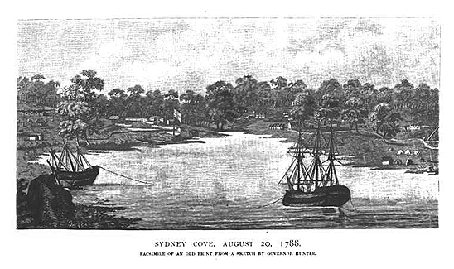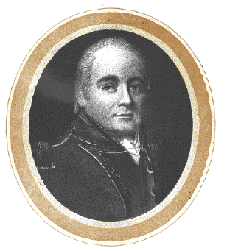A Convict Settlement in Sydney

The British colony of New South Wales was established in 1788 as a penal colony. After the American War of Independence, Britain, in a time of social upheaval at the beginnings of massive agricultural, industrial and social change, was faced with overcrowded prisons and prison ships and no suitable destination to transport their convicts Lieutenant James Cook's discovery and annexation for Britain of the east coast of Australia in 1770, now aroused new interest. In particular, Sir Joseph Banks, the influential Botanist who had accompanied Cook on the voyage, strongly supported "Botany Bay" as a site for a new British settlement and convict colony. For this and for related strategic and commercial reasons, the British government decided, to embark on the new settlement project.
The first settlement, at Sydney, consisted of about 850 convicts and their Marine guards and officers, led by Governor Arthur Phillip. They arrived at Botany Bay in the "First Fleet" of 9 transport ships accompanied by 2 small warships, in January, 1788. Finding the area unsuitable for settlement, they actually settled at Sydney Cove in Port Jackson (or Sydney Harbour as it is better known) on January 26, the date now celebrated nationally as "Australia Day".
In such a society, the emerging European and American concepts of democracy and liberalism at first had no place. The early years were increasingly desperate ones as the colony struggled to establish and feed itself. By 1792, the first signs of stability were appearing but Governor Phillip, weakened by illness and the deprivations of those years, returned to England, leaving the colony in the hands of military Lieutenant-Governors.
The arrival of the first free settlers, five single men and two families, in 1793 was the first sign of a need for change. The number of free settlers and merchants steadily grew, as did the number of native born people and convicts who had served their time and were now free citizens. And, as the size and importance of the free citizenry grew in relation to that of the convicts and military, so, inevitably, would also grow a demand for democratic change.
The Early Governors of New South Wales
Governor Phillip (1788-92) was succeeded as Governor by Governors John Hunter, 1795-1800, Philip Gidley King, 1800-06, and William Bligh, 1806-08 (the famous Captain Bligh of the "Mutiny on the Bounty").
Until 1824, the military governors of New South Wales were absolute rulers, the only power superior to them being the British Parliament at Westminster in England, nearly 20,000 kilometres and 8 months away by sea. The governors' rights were granted to them under an Act of the British Parliament of 1787, which gave them their commissions and instructions, but the distance and the infrequency of communication with the rest of the world meant that governors often exercised far wider powers than they had been given.
While governors retained virtually absolute authority, a great deal of effective power in the colony lay with the
military, in particular the officers of the New South Wales Corps raised especially for duty in the colony from 1790 on. The officers quickly gained significant land holdings and monopoly control over trade, especially of rum and alcohol imports.
The Rum Rebellion
 Governor William Bligh
Governor William Bligh
The military force stationed in New South Wales from 1792-1810 was a specially raised unit, the New South Wales Corps. They were nicknamed the "Rum Corps" because of their monopoly in trading in spirits. From 1806, the Governor of New South Wales was Captain (later Admiral) William Bligh. Bligh, a talented and strong naval officer, has been somewhat vilified as an excessive disciplinarian in the accounts of the mutiny that took place on his ship, HMS Bounty, in 1789. He recognised that the officers, in particular, of the New South Wales "Rum" Corps were an entrenched power acting in their own interests. In particular, Bligh saw that the small, non-military farmers were being discriminated against by the Corps.
As Bligh attempted to assert his legitimate authority, the Corps officers clashed with the Governor over several issues including his support of small settlers and tensions grew. On January 26, 1808, the troops, led by Lt-Col. George Johnston, arrested Bligh and took over control of the Colony. A number of Bligh supporters were arrested, some spending the next two years in convict work gangs.
This was Australia's only military coup. The New South Wales Corps remained in control until 1810 when the British government sent a new Governor (Macquarie) with his own regiment, disbanding the New South Wales Corps.
Beginnings of a Judicial System
Even though political change had to wait until the 1820s and beyond, other elements of the future system of government were also beginning their evolution.
In New South Wales, the governors had the responsibility of putting into effect the Statute and Common law of England. At first, the newcomers consisted only of convicts, their military guards and the officials sent to administer the colony. In the first weeks after the arrival of the British, most of the legal problems which arose were of a criminal nature, and were dealt with summarily under military law; but an Act Constituting a Court of Criminal Judicature in NSW had been passed by the Imperial Parliament in 1787, and the First Charter of Justice for New South Wales was issued under Letters Patent of 2 April, 1787, to constitute a Court of Civil Jurisdiction.
On 11 February, 1788, the first court of law in colonial Australia met, with three naval officers and three marines sitting with Judge Advocate Collins as members of the court. Originally, Governor Phillip, Lieutenant-Governor Ross and Judge Advocate David Collins acted as Justices of the Peace. Phillip was later given the right to appoint additional Justices of the Peace. Like their English counterparts, these Justices of the Peace, or magistrates, undertook both judicial and administrative duties.
